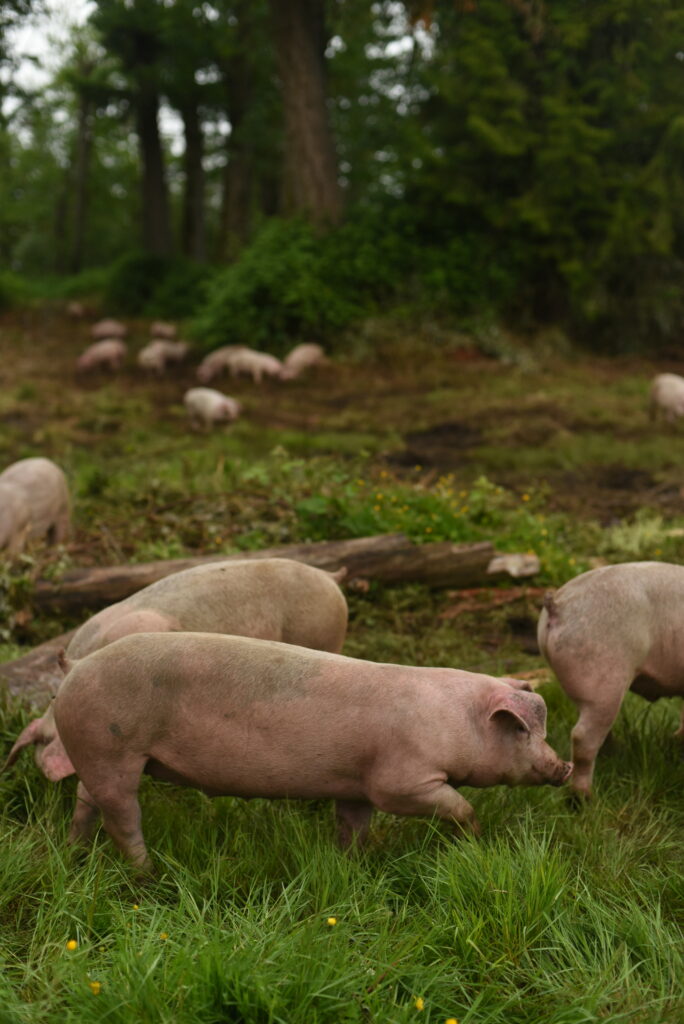
The Forest Tells Us When to Raise Pork
We raise most of our pigs in a beautiful silvopasture—our woods, where they root and roam under tall trees, snacking on brambles and wild forage. It’s the kind of life pigs dream about… until the weather shifts.
Once the rains come, the ground turns soggy, the forage fades, and the pigs start huddling instead of exploring. That’s our cue: grazing season is over.
So we do what farmers have done for generations—we harvest in bulk, tuck the pork away, and let the forest rest. That’s seasonal farming. Not factory schedules. Not forced year-round production. Just animals and land, living in rhythm.
Why Our Chickens Get the Winter Off
Our chickens are outside every day—on fresh pasture, scratching through grass, chasing bugs, and sunbathing like little feathery weirdos. They love it. But here’s the truth: chickens hate the cold.
Once the frost hits, they stop ranging. They sulk in corners. And when the ground gets icy? Forget it. Their water freezes, and so do their fluffy attitudes.
We could raise them indoors like industrial farms do—but that’s not us. Instead, we raise our birds seasonally, let the land breathe, and freeze what we need for the rest of the year.

The Magic of Vacuum-Sealed Meat and a -10°F Freezer
Because we raise pork and chicken when the seasons allow, we do a lot of bulk processing. Everything is vacuum sealed immediately after butchery and stashed in our commercial freezer, which hangs out at a brisk -10°F.
That low temp slows down oxidation and stops freezer burn in its tracks. And vacuum sealing? It’s like shrink-wrapping time. No air = no spoilage.
That’s how we can say, with confidence:
Most of our vacuum-sealed meats are just fine for well over a year.
We’ve pulled pork roasts out at the 18-month mark and had them taste just as good as the ones packed last week.
Wait—Is Meat Still Good After the Best-By Date?
Short answer: Yes.
Long answer: Also yes, and here’s why.
Those “best by” dates? They’re about quality, not safety. If your meat has been frozen solid, seal intact, and it smells normal once thawed—you’re good to go.
Even if it’s been tucked away for a while, a slightly older cut will still shine in slow-cooked meals like:
- Pulled pork sandwiches
- Chicken tortilla soup
- Bolognese
- Tacos, stir-fries, stews—you name it
And frankly, in this house, we don’t waste meat that was raised with this much care. Not ever.
Tips to Keep Your Freezer Stash Thriving
Wanna be a meat-hoarding pro like us? Here’s what we do:
- Keep the oldest cuts up front or on top
- Write the pack date in Sharpie if you like the visual reminder
- Store meats in the coldest part of your freezer (not the door)
- Don’t open the vacuum seal until you’re ready to use it
- Use older cuts in braises, soups, or pressure cooker meals
Your Freezer’s Best Friend: Our Variety Box
If you want to fill your freezer with food that actually lasts and doesn’t come from mass production—start here:
? Our Pork Variety Box with Uncured Pork Belly Bacon
It’s packed with pasture-raised meats, sealed for the long haul, and grown with the same seasonal rhythm we live by.
Final Thought: We Don’t Farm for Convenience
We farm for flavor. For animal welfare. For our soil. For you.
Seasonal farming means some months we’re flush with chicken, and others, we’re counting the days until the next hatch. It means walking away from “always in stock” and leaning into the ebb and flow of real food raised outdoors.
But with the right tools—like vacuum sealing and deep freezing—you can eat like it’s summer in April before the new grazing season has even begin, without compromising values.
And that’s the kind of slow, steady, freezer-filling magic we’re all about.
PLEASE COMMENT BELOW